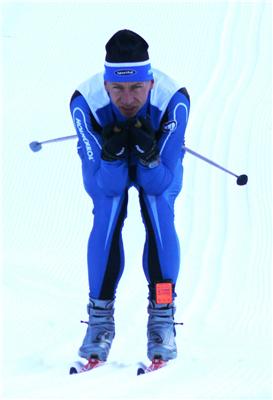Jan 11 2010
In ski sports, it's often only a second that separates the winners from the losers. Using equipment made of the right materials can therefore make all the difference. Researchers are simulating the gliding effects that occur when skis travel over snow - and creating super fast skis.
 In search of speed.
In search of speed.
You couldn't have asked for a better day for a competition. It's minus five degrees, the sun's shining and there's not a breath of wind. The snow's perfect and the biathlete's in top form. He's one of the best - he can win the race. Often there's only a few thousandths of a second between the victor and the vanquished, so the gliding ability of his skis is very important. And this depends on several factors, not least whether the wax mixture he's applied suits the particular type of snow.
Anyone looking for optimal ski performance must first understand the laws of friction. That is why wax and ski coating manufacturers are counting on the expertise of researchers at the Fraunhofer Institute for Mechanics of Materials IWM in Freiburg. The scientists have been studying the gliding ability of skis and know how to make ski athletes go like the wind. Prof. Dr. Matthias Scherge, Head of the new Microtrobilogy Center in Karlsruhe, says: »The snow, the ski coating and the wax that is applied all unite to form a single entity. We can't alter the snow, but we can adapt both the wax and the coating to suit particular snow conditions.« The researchers use a special technique to analyze the friction and gliding effects; they simulate the contact between a single snow crystal and the coating with the aid of a test rig, and then measure the coefficient of friction in relation to temperature. »It's the first 10 to 15 nanometers of the coating surface that
determine the gliding effects,« explains Scherge. And they have another item of equipment in their armory as well: a ski tribometer. Here, a small section of ski travels in a circle over a snow-covered disc, allowing the researchers to test different combinations of waxes and coatings and ascertain the optimum combinations for specific conditions such as temperature. The ultimate test is then conducted in the ski hall, where biathletes perform glide tests on a hundred-meter test run with a defined gradient. Their times are measured with the aid of a leg-mounted transponder, which guarantees split-second accuracy; this enables the researchers to establish how many thousandths of a second can be shaved off their times by the right combination of ski coating and wax.
The researchers are working with Holmenkol and other partners to develop novel waxes and super fast coatings. Scherge says: »We've talked with athletes and also with the technicians who wax their skis prior to every competition. It's only with their knowledge and experience that we'll be able to create skis that glide perfectly.«